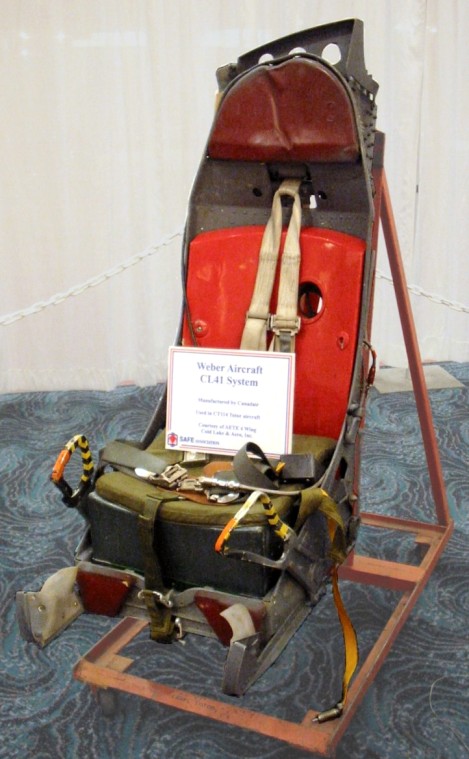

This seat was built by Weber Aircraft and is still in use in the Canadair CT-114 Tudor trainer. The photographed seat shown is one that was modified by Aero to improve seat separation, and used in a test program.
The Canadian Air Force determined that the standard rotary actuator (butt-snapper) system was giving inadequate seat separation. This could lead to seat impacting with either the crewman or the parachute as the parachute deployed, potentially risking injury to the crewman. Aero developed a modification which consists of a 36 inch drogue parachute and telescoping arm to provide additional drag on the seat. This provides greater clearance between the crewman and the seat by slowing the seat at a rate that changes its trajectory at a different rate than the parachute does the crewman's trajectory.
The arm is mounted on the seat back on the outboard side of the rails along with the pack for the drogue parachute. A cable static line releases the pack during seat movement and arms the release for the telescoping arm. As the seat separates from the aircraft the 36 inch drogue is aerodynamically deployed. It rapidly fills and begins to become effective. As an unintended benefit it acts to stabilize the seat in flight. 0.8 seconds after the cable arms the release the arm is unlocked and the drogue pulls the arm downward to the lock position, then extends the telescoping section to its maximum length of about 5 feet. The seat systems are unaffected by the addition of the drogue system and therefore at approxamately 1 second after seat ejection the seat separation system begins to function.
The lap belt (a new Koch design) is released by gas pressure. This belt uses the standard shoulder harness but incorporates a negative G strap. Then the seat separation rotary initiator would fire to push the aircrew away from the seat. The lap belt would separate at a point where it would retain the parachute arming lanyard and this would start the parachute deployment.
The drogue/arm system at this point would help retard the seat to allow for much greater separation than normal. As the main recovery parachute deploys the seat would safely fall away from the crewman and parachute. This system was developed for the CT-133 ejection seat originally by Aerospace Equipment Research Organization (AERO). This system is based on, but different from the one used on the CT-133.
| View of the folded arm. The drogue pack can be seen at the top of the arm. A link can be seen where the innermost segment of the telescoping arm is connected to the drogue bridle. A cotter pin is installed to prevent the a rm from deploying during ground handling. The wire with the yellow markings is the lanyard connection for releasing the drogue and arming the release for the arm. The hingepoint at the base is visible. hidden from view is the bracing arm that slips down to prevent the arm from retracting after deployment. |
| Upper portion of the arm showing the packed drogue container. |
| 3/4 right view |
This system was on display at theSAFE Association History of Escape Systems and the Evolution of Manikins Display during the SAFE Association 40th annual Symposium, October 2002. Special thanks to the people from AERO for the description of the test program and drogue function. Thanks to Jean Potvin for providing some of the photos on this page.
| The Ejection Site Home | |
|---|---|
| Send email to Kevin |